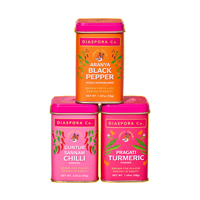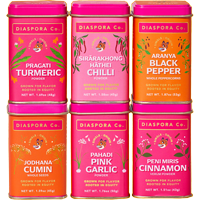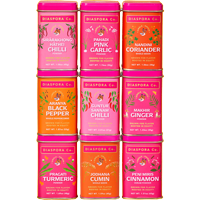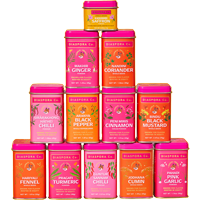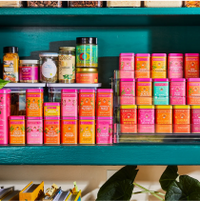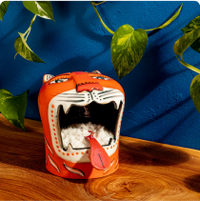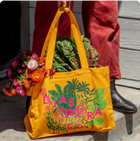
The potato filling flavorings for samosas vary from household to household. This combination of Jodhana Cumin, Pragati Turmeric, Sannam Chillies and Garam Masala is a personal favorite of mine, but feel free to play around with the spices to find a mix you adore. The two things that are non-negotiable when it comes to aloo samosa in my house are: 1) Wild Ajwain in the dough [it lends a beautiful herbaceous flavor that complements the potato, and also plays well with meat fillings, too.] 2) a tangy element added to the filling, like amchur powder [you can use 2 teaspoons lemon juice if you don't have amchur].
The frying method is inspired by the street stalls selling samosas—first the samosas are fried at a lower temperature to cook the pastry through and then the heat under the pot is increased, turning the exterior deep golden.

Asha's Potato Samosas
The potato filling flavorings for samosas vary from household to household. This combination of Jodhana Cumin, Pragati Turmeric, Sannam Chillies and Garam Masala is a personal favorite of mine, but feel free to play around with the spices to find a mix you adore. The two things that are non-negotiable when it comes to aloo samosa in my house are: 1) Wild Ajwain in the dough [it lends a beautiful herbaceous flavor that complements the potato, and also plays well with meat fillings, too.] 2) a tangy element added to the filling, like amchur powder [you can use 2 teaspoons lemon juice if you don't have amchur].
The frying method is inspired by the street stalls selling samosas—first the samosas are fried at a lower temperature to cook the pastry through and then the heat under the pot is increased, turning the exterior deep golden.
Ingredients
For the dough
- 2 1/2 cups all-purpose flour
- 1 teaspoon kosher salt
- 1/2 teaspoon Wild Ajwain
- 4 tablespoons ghee, melted
- 1/2 cup water
For the filling
- 1 1/4 pound Yukon Gold potatoes, halved
- 1 tablespoon ghee or neutral oil
- 1 teaspoon Jodhana Cumin
- 1 serrano chilli, finely chopped
- 1 teaspoon Garam Masala
- 1/2 teaspoon Pragati Turmeric
- 1/2 teaspoon powdered Guntur Sannam Chillies
- 1/2 cup frozen peas, thawed
- 1 teaspoon amchur powder
- 1 teaspoon kosher salt
- 1/4 cup cilantro, tender leaves & stems, finely chopped
Neutral oil, like canola or grapeseed, for frying
Methods
For the dough
- Combine the flour, salt and ajwain in a large bowl and mix to combine with your hands. Add the melted ghee and, using your hands, rub the ghee into the flour (as you would for making a short crust pastry) until the mixture looks like coarse sand. Add 1/2 cup water and gently bring the dough together. If the dough is too dry, add 1 tablespoon at a time until it comes together. Turn out onto a clean surface and knead it a few times until it forms a ball, about 30 seconds. (This is a pastry, so make sure not to over-knead!)
- Flatten the dough into a rectangle, wrap in plastic wrap and let sit at room temperature for 45 minutes.
For the filling
- While the dough is resting, make the filling. Place the potatoes in a medium pot, cover with cold water and season liberally with salt (about 2 tablespoons—this is your chance to season the potatoes from the inside out!). Place the pot over medium high heat and bring to a boil. Reduce the heat to medium and simmer until the potatoes are tender, about 15 to 20 minutes, depending on the size of your potatoes. Drain and let cool for 10 minutes. Remove the peels, discarding them or saving them for another use, and set the peeled, cooked potatoes aside.
- In a large skillet, heat the ghee over medium heat. Add the cumin seeds and cook until they start to turn light golden and become fragrant, about 30 seconds to 1 minute. Add the serrano pepper and continue to cook until it starts to soften, about 1 minute more. Add the garam masala, turmeric and Sannam chillies and continue to cook for 30 seconds.
- Reduce the heat to medium low and add the potatoes, breaking them up into small pieces, ranging from the size of a pea to a marble, with a wooden spoon. Stir in the peas, making sure everything is coated in the spices, and cook until everything is just heated through, about 2–3 minutes. Turn off the heat and stir in the amchur powder, salt and cilantro. Set aside.
To assemble
- Unwrap the dough and divide it into three, equal pieces. Loosely rewrap the two pieces you aren't using in the plastic wrap. Take one piece, cut it in half and roll it into a ball. Flatten the ball with your hands and then, using a rolling pin, roll it into an oval about 8 inches x 6 inches. Cut the oval in half crosswise, so you are left with two half moons, 4 inches x 6 inches.
- Take one half moon and lightly wet the straight edge with water using your fingers. Bring the two straight edges together, slightly overlapping by 1/4-inch and pinching together to create a cone. Nestle the cone in your hand with the seam resting on your index finger and the other side draped over your thumb. Spoon a couple tablespoons of filling into the cavity, gently packing it in with the back of the spoon. To close, lightly wet one side of the edge of the cone and then press the two edges together to seal the samosa. Place on a baking sheet, cover with a clean kitchen towel and repeat with the remaining dough and filling.
To fry & serve
- Heat about 3 inches canola oil in a large pot or Dutch oven over medium high heat to 300°F. Fry the samosas in batches. Gently place half of the samosas in oil and fry until the wrappers start to blister and turn very light golden, about 4–5 minutes. Increase the heat to high and continue to fry the samosas until they are golden brown, about another 3–4 minutes. Transfer the fried samosas to a paper towel-lined baking sheet. Repeat the frying process with the remaining half.
- Serve warm or at room temperature with the chutney of your choice and a hot cup of Sana's Kadak Spicy Chai!



